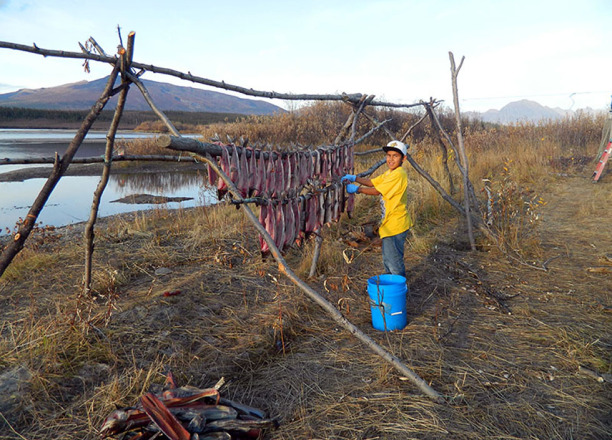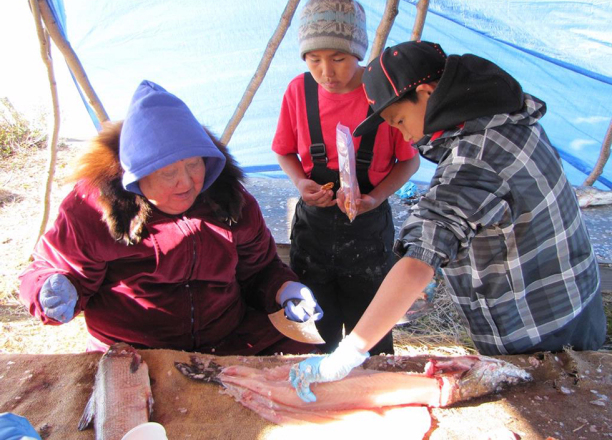This week, NOAA’s Office of Response and Restoration is looking at the range of values and benefits that coastal areas offer people—including what we stand to lose when oil spills and chemical pollution harm nature and how we work to restore our lost uses of nature afterward. Read all the stories.

When I’ve heard residents of the Alaskan Arctic speak about the potential impacts of an oil spill, I don’t hear any lines of separation between the oil spill causing injury to the environment and injury to the community.
Their discussions about the potential harm to walrus or seals inevitably include how this will impact the community’s ability to hunt for food, which affects both their food security and traditions. The cultures of these communities are inextricably tied to the land and sea.
So I ask myself, in the wake of an oil spill in the Arctic, how would we begin to restore that bond between the environment and the communities who live there? How can we even begin to make up for the lost hunting trips between grandparents and grandkids that don’t happen because of an oil spill? Furthermore, how could we help restore the lost knowledge that gets passed down between generations during such activities?
We know nothing can truly replace those vital cultural exchanges and activities that don’t occur because of pollution, but we have to try. Thanks to our federal Natural Resource Damage Assessment laws, polluters are made accountable for these lost cultural uses of natural resources, as well as for the harm to affected lands, waters, plants, and animals.

Here are a few examples of our efforts to restore these cultural uses of coastal resources after they’ve been harmed by oil and chemical spills, as well as some ideas for the future.
Community Camps in Alaska
When the M/V Kuroshima ran around on Unalaska Island, Alaska, in November 1997, approximately 39,000 gallons of heavy oil spilled into Summer Bay, Unalaska’s prime recreational beach. As a result of the spill, access to the bay and its beach was closed off or restricted for several months.
In an effort to restore the lost use of their beach, the local Qawalangin Tribe received funding for an outdoor summer recreational camp, which focuses on tribal and cultural projects such as traditional subsistence harvesting techniques for shellfish and activities with Unangan elders in Alaska’s Aleutian Islands. To ensure the safety of local seafoods eaten by the tribe, NOAA also arranged for further chemical analysis of shellfish tissues and educated the community about the results.
Cultural Apprenticeships in New York
Years of aluminum and hydraulic fluid manufacturing released toxic substances such as PCBs into New York’s St. Lawrence River, near the Canadian border. This history of pollution robbed the St. Regis Mohawk Tribe, whose Mohawk name is Akwesasne, of the full ability to practice numerous culturally important activities, such as fishing. Legal settlements with those responsible for the pollution have provided funding for the tribe to implement cultural programs to help make up for those losses.
But first, representatives from the St. Regis Mohawk Tribe conducted oral history research, hosted community outreach meetings, and solicited restoration project ideas from the community. As a result of these efforts, they determined that two main components of restoration [PDF] were necessary: an apprenticeship program and funding for cultural institutions and programs.
The long-term, master-apprentice relationship program focuses on the four areas of traditional cultural practices that were harmed by the release of hazardous contaminants into the St. Lawrence River and surrounding area. This program also promotes and supports the regeneration of practices associated with traditions in these four areas:
- Water, fishing, and use of the river.
- Horticulture and basketmaking.
- Medicinal plants and healing.
- Hunting and trapping.
Hands-on experience and Mohawk language training are also integral parts of the apprenticeship program.
In addition to this program, resources have been provided to a number of existing Akwesasne-based programs that have already begun the work of responding to the cultural harm caused by this contamination. One example is providing opportunities for Akwesasne youth and surrounding communities to receive outdoor educational experience in a natural and safe location for traditional teachings, such as respect for the land and survival skills.
Planning for the Worst and Hoping for the Best in the Arctic

Discussions with Alaskan Arctic communities have yielded similar suggestions of potential forms of cultural restoration after pollution. A 2012 multi-day workshop with communities in Kotzebue, Alaska, generated an initial list of ideas, including:
- Teaching traditional celebrations (e.g., foot races and dances).
- Teaching subsistence practices and survival techniques.
- Supporting science fairs with an environmental restoration focus.
- Maintaining and transferring hunting knowledge by educating youth on proper whale, seal, and walrus hunting methods.
This last idea is particularly intriguing and would involve preparing a “virtual hunt” curriculum on how to shoot whales so they can be recovered, how to butcher an animal, and sharing the results of the hunt with others.
After working here at NOAA since 2008, I can rattle off plenty of restoration ideas for an oiled beach, or oiled birds. But when it comes to restoring lost cultural uses of the environment, there are no off-the-shelf project ideas.
Each tribe is unique and how one tribe’s members interact with their natural environment may not be the same as another tribe’s. While there may be similar themes we can build upon, such as teaching language and harvesting skills, we need to work closely with each tribe affected by an oil or chemical spill to help them achieve once again what pollution has taken away.
